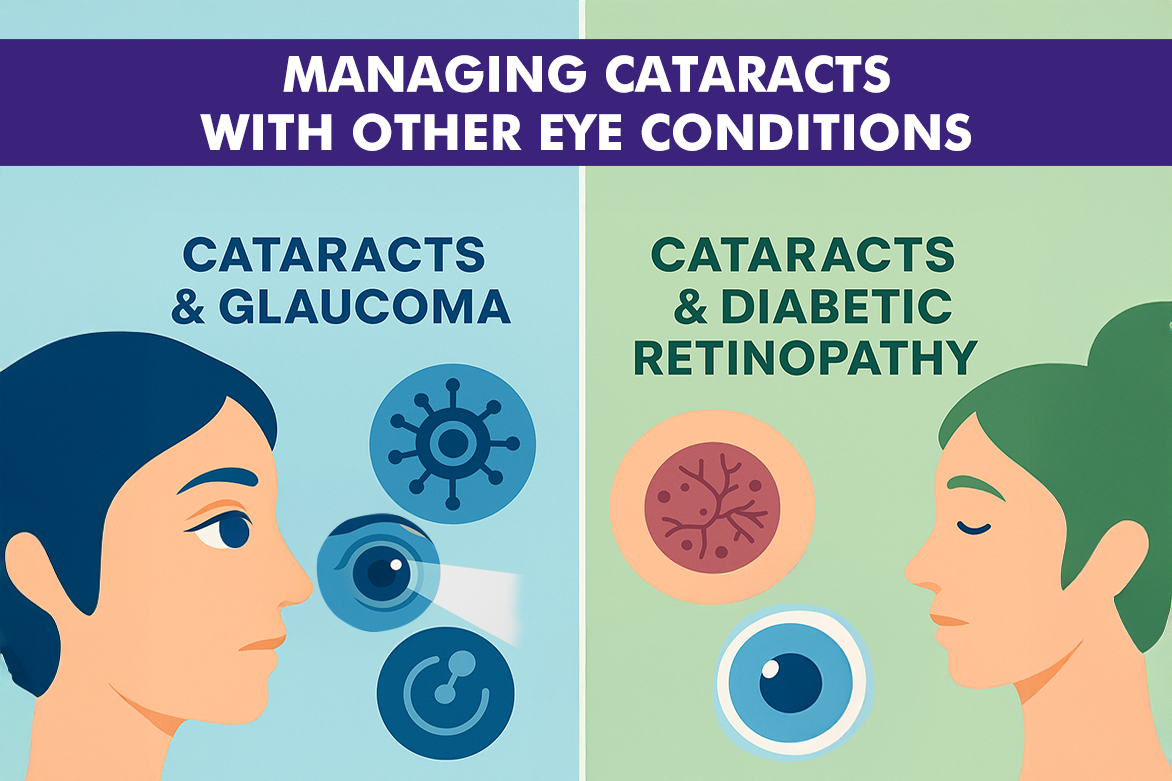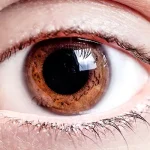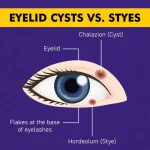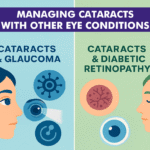Table of Contents
- Understanding Cataracts and Their Symptoms
- Common Eye Conditions That Coexist with Cataracts
- How Different Eye Conditions Interact
- Managing Cataracts with Glaucoma
- Macular Degeneration and Cataract Co-Management
- Corneal Disease and Cataract Surgery
- Diagnostic Approaches for Multiple Eye Conditions
- Treatment Options for Cataracts and Coexisting Eye Conditions
Cataracts are one of the leading causes of blindness across the globe, especially for adults over the age of 60. But for many, cataracts aren’t the only battle—other eye conditions like glaucoma, macular degeneration, diabetes-related eye problems, and corneal diseases may complicate both diagnosis and treatment. If you or a loved one is facing cataracts alongside other eye conditions, knowing your options is the first step to clear sight and a better quality of life.
This comprehensive guide will help you master the essentials, so you feel empowered to ask the right questions, make smart decisions, and take control of your vision health.
Understanding Cataracts and Their Symptoms
A cataract is the clouding of the natural lens within your eye, similar to a fogged-up window or a camera lens coated with mist. Cataracts typically develop slowly, affecting daily tasks such as reading, driving, and recognizing faces.
Most Common Symptoms of Cataract
- Blurry or cloudy vision
- Faded colors or poor contrast
- Difficulty seeing in dim light or at night
- Glare or ‘halos’ around lights, especially when driving at night
- Frequent changes in prescription glasses
- Double vision in one eye
Why Early Detection Matters
Cataracts can be subtle at first and are easily confused with other age-related eye issues. Routine eye exams—at least once per year after age 60—can catch them before they become a major obstacle.
Sudden vision loss
| Symptom | Possible Cause | Suggestion |
| Decreased night vision | Cataract/glaucoma | Eye exam |
| Glare/halos | Cataract/corneal problem | Check with an ophthalmologist |
| Retinal/macular issue | Emergency appointment |
Common Eye Conditions That Coexist with Cataracts
For many older adults, cataracts are just one piece of the puzzle. It is common for patients to have one or more of the following conditions:
-
- Glaucoma: Increased eye pressure damages the optic nerve.
- Macular Degeneration: Degeneration of the macula leads to poor central vision.
- Diabetic Retinopathy: High blood sugar damages blood vessels in the retina.
- Corneal Diseases: Conditions like keratoconus and Fuchs’ dystrophy affect the cornea’s shape and clarity.
- Retinal Detachment or Tears: More common in aging eyes, especially with prior surgeries.
How Different Eye Conditions Interact:
Each condition has its own mechanisms and symptoms, but their coexistence complicates diagnosis, blurs symptom boundaries, and influences surgical planning. For example, both glaucoma and cataracts can simultaneously blur vision, making it important to pinpoint which is causing the symptoms.
Corneal Diseases
| Condition | Key Challenge with Cataracts | Special Considerations |
| Glaucoma | Pressure management during surgery | Surgical timing, medication use |
| Macular Degeneration | Poor visual prognosis post-surgery | Pre-op retinal assessment |
| Diabetic Retinopathy | Risk of bleeding/swelling post-surgery | Blood sugar/steroid control |
| Compromised healing/visual outcome | Choose proper lens/surgical method |
Managing Cataracts with Glaucoma
Glaucoma impacts the optic nerve and is a silent thief of sight, and so is the slow progress of cataracts. When both exist together, careful management is crucial.
Key Points in Co-Management:
Diagnostic Challenge: Cataract cloudiness can mask glaucoma’s early signs.
Pressure Control: Cataract surgery may lower eye pressure, but some cases need combined glaucoma/cataract surgery.
Medication Interactions: Some glaucoma drops may affect cataract progression.
Treatment Options: Eye pressure-lowering medications (as prescribed) & Laser treatments for select glaucoma types.
Surgical options: Combined phaco-trabeculectomy or minimally invasive glaucoma surgery (MIGS) at the time of cataract removal
Macular Degeneration and Cataract Co-Management
The macula is the central area of the retina responsible for sharp, straight-ahead vision. Macular degeneration (AMD) is a leading cause of blindness and another common eye problem in aging eyes.
How is it managed?
Surgery Timing: Vision restoration may be limited by AMD. Accurate macular scans are critical before cataract surgery.
Injections/Therapy: Some patients get anti-VEGF injections to slow AMD progression.
Visual Expectations: Cataract removal can still improve clarity, color, and contrast, but won’t restore areas affected by AMD.
Corneal Disease and Cataract Surgery
The cornea is the window through which all light enters our eyes. Diseases like keratoconus, Fuchs’ dystrophy, and post-infective scars add complexity to routine cataract surgery.
Pre & Post-Operation Procedures:
-
- Detailed mapping of corneal shape (topography)
- Assessing the endothelial cell count to predict healing
- Choosing between standard, toric, or specialty intraocular lenses (IOLs)
- Surgeons may alter techniques or use adjunct procedures, e.g., Descemet Membrane Endothelial Keratoplasty (DMEK) if necessary.
- Healing may be slower; intermediate visual distortions may occur as the eye recovers.
Diagnostic Approaches for Multiple Eye Conditions
Multidisciplinary diagnosis is the backbone of safe and successful treatment when multiple eye conditions coexist with cataracts.
Comprehensive Evaluation May Include:
- Visual Acuity Testing: Measures central and peripheral sight
- Slit Lamp Examination: Evaluates cataracts, cornea, and anterior chamber
- Intraocular Pressure (IOP) Testing: Key for glaucoma diagnosis
- Optical Coherence Tomography (OCT): Detailed images of retina/macula, helps with AMD/diabetic retinopathy
- Fundus Photography: Documents retinal health over time
- Corneal Topography: For patients with irregular corneas
- Fluorescein Angiography: For diabetics and AMD
A full assessment highlights subtle issues, allowing tailored treatment for each individual.
Treatment Options for Cataracts and Coexisting Eye Conditions
Management plans must be personalized, considering the interaction of every condition.
| Condition | Primary Strategy | Considerations |
| Cataract + Glaucoma | Combined surgery and medication | Monitor pressure closely post-op |
| Cataract + AMD | Cataract removal, ongoing AMD therapy | Adjust visual expectations |
| Cataract + Diabetic Retinopathy | Control sugar, anti-VEGF, and cataract timing | Monitor for post-op swelling |
| Cataract + Corneal Disease | Difficulty in IOL power measurement, slower healing. May need customized IOL. | Frequently reassess vision |
Other essential treatment options
- Medications: Drops for pressure, steroids for swelling, injections for AMD/diabetics.
- Laser Treatments: For glaucoma and diabetic eye changes.
- Lifestyle Modifications: Nutritious diet, smoke cessation, glucose control.
Preventative Measures and Lifestyle Adjustments
Effective prevention and daily management can reduce the risk and slow the progression of cataracts and other eye diseases.
- Wear UV-protective sunglasses.
- Eat a diet high in colorful vegetables (carrots, spinach, oranges) and fatty fish (rich in omega-3s).
- Maintain strict diabetes and blood pressure control.
- Avoid smoking and excessive alcohol intake.
- Increase room lighting for reading and focus tasks.
- Get regular, comprehensive eye exams.
- Review all medications for possible side effects impacting eye health.
How healthy habits boost your eye health
Conclusion
Effectively managing cataracts alongside other eye conditions requires a comprehensive, individualized, and often multidisciplinary approach. By understanding each condition and how they interact, making informed lifestyle choices, and maintaining regular eye care appointments, you can give yourself the very best chance at sharp, comfortable vision for life.
Remember, you are not alone—Centre For Sight, India’s leading eye care hospital chain, is there to provide tailored treatment for every ailment.





